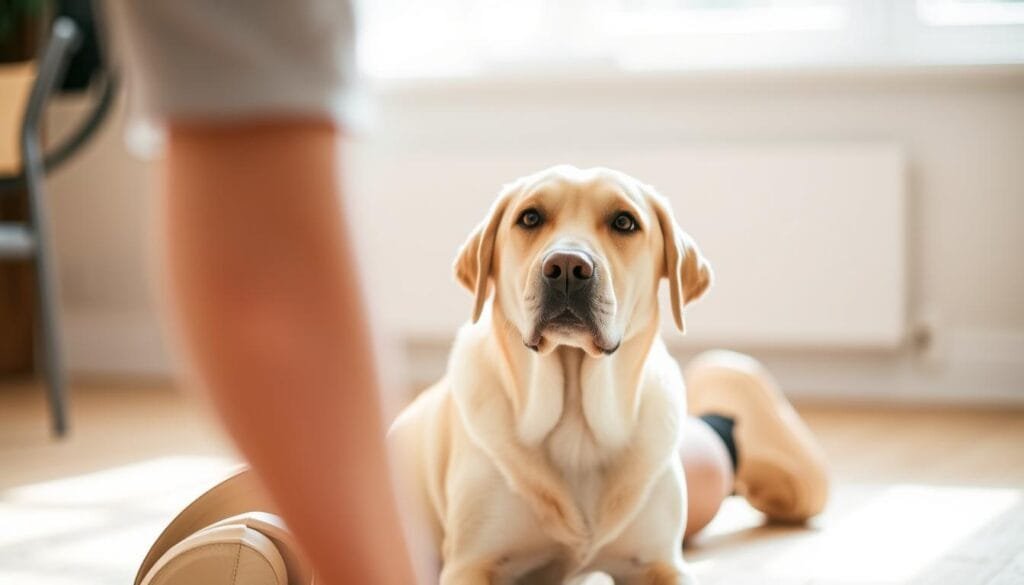Bichon Frise Dog Training: Proven Methods for a Well-Behaved Pup
What if the key to a perfectly behaved companion lies not in endless commands, but in understanding their unique needs? Many owners assume fluffy breeds respond best to strict routines, yet Malcolm from activk9s in Clonmel reveals a different truth: “These spirited pups thrive on connection, not control.”
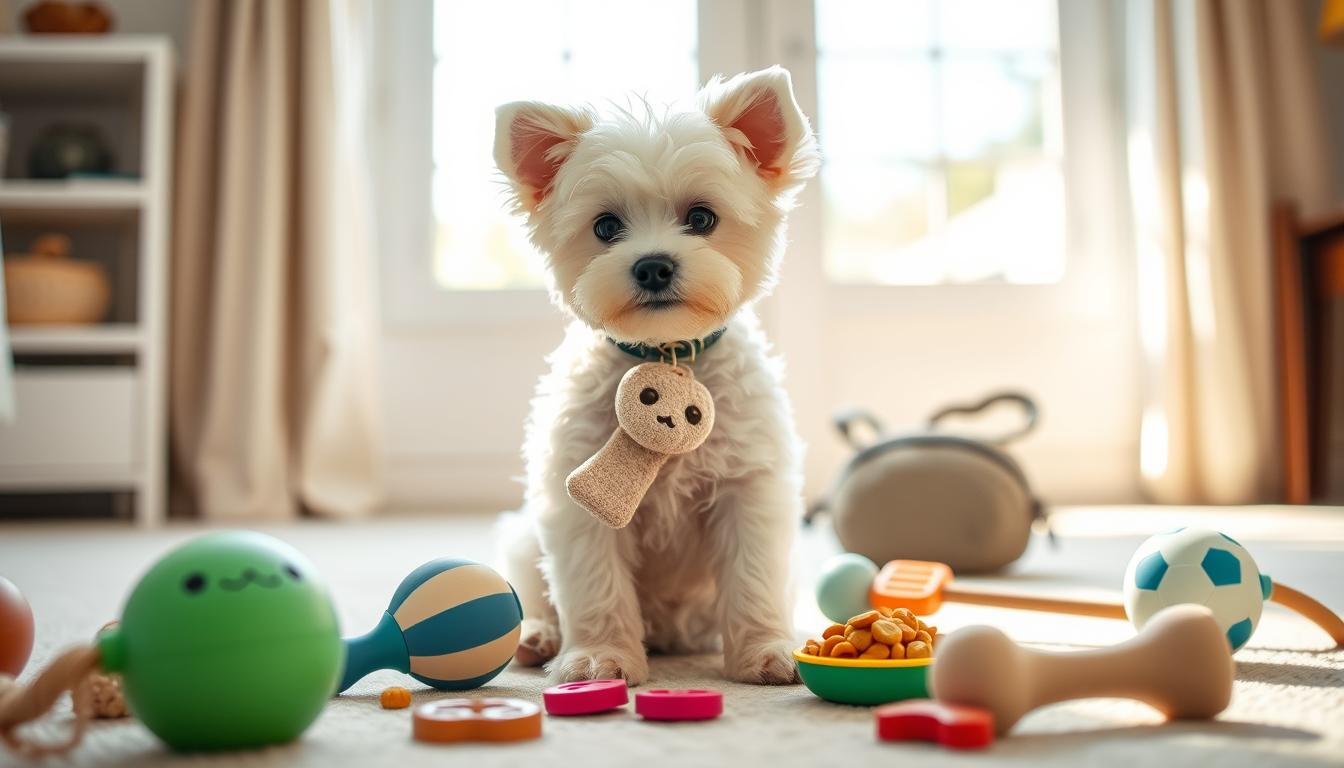
Early socialisation shapes their confidence. Without it, even the most affectionate pups may develop timid habits or excessive barking. Structured guidance – like the tailored sessions Malcolm offers via 089-4120124 – builds trust while curbing unwanted behaviours.
Consistency matters more than duration. Short, engaging practices using rewards create lasting results. Think of it as nurturing their natural curiosity rather than enforcing obedience. This approach aligns with their sensitive temperament, transforming challenges into bonding opportunities.
Key Takeaways
- Early socialisation prevents timidness and establishes confidence in young pups.
- Professional guidance from experts like Malcolm enhances training effectiveness.
- Positive reinforcement techniques foster trust and quicker learning.
- Consistent, brief sessions yield better results than sporadic lengthy drills.
- Tailored methods address breed-specific traits for optimal outcomes.
Introduction to Bichon Frise Dog Training
Building a harmonious relationship with your fluffy companion begins with purposeful guidance. Unlike generic approaches, structured programmes adapt to their playful yet sensitive nature. Studies show pups exposed to socialisation before 14 weeks develop 40% fewer behavioural issues later in life.
https://www.youtube.com/watch?v=ouK9tIF9gwI
Overview of Proven Training Methods
Start with three pillars: basic commands, environmental exposure, and crate familiarity. Short 10-minute sessions using rewards like chicken pieces work best for attention spans. Malcolm at activk9s notes: “Owners who master ‘sit-stay-come’ early see 50% faster progress in advanced skills.”
| Method | Purpose | Average Mastery Time |
|---|---|---|
| Positive Reinforcement | Encourages repetition of desired actions | 2-3 weeks |
| Controlled Socialisation | Reduces anxiety in new situations | 4-6 weeks |
| Crate Conditioning | Creates safe resting space | 1-2 weeks |
Setting Your Training Goals
Define specific targets like “walk politely on lead” or “greet visitors calmly”. Clarity prevents frustration – vague aims like “behave better” lack measurable outcomes. Professionals like Malcolm use custom plans addressing individual quirks, available via 089-4120124 in Tipperary.
Prioritise consistency over complexity. Daily 5-minute drills yield better results than weekly hour-long marathons. This rhythm aligns with their need for routine while strengthening your bond through shared achievements.
Understanding Your Bichon Frise’s Unique Needs
Have you ever wondered why some pups respond brilliantly to praise while others need more creative motivation? These spirited companions possess distinct traits that demand tailored approaches. Recognising their individuality unlocks faster progress and deeper bonds.
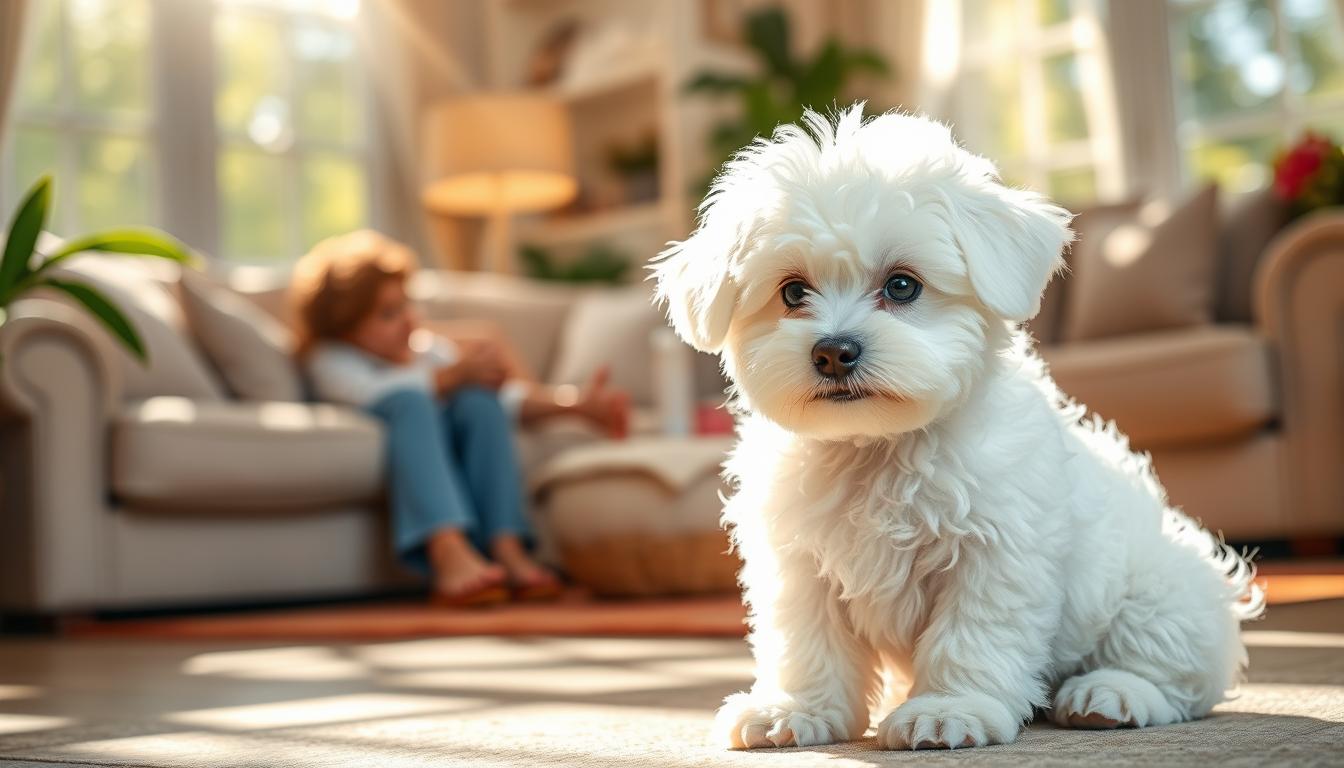
Breed Characteristics and Temperament
This breed thrives on companionship, often shadowing family members throughout the day. Their intelligence shines through quick problem-solving, yet short attention spans require varied activities. Reputable studies highlight their sensitivity to tone – harsh corrections may trigger anxiety, while enthusiastic praise fuels eagerness.
Social by nature, they develop confidence through gradual exposure to new environments. Puppies introduced to diverse sounds and surfaces before 16 weeks adapt better to adult life. Their playful disposition makes them ideal for homes with children, provided boundaries are gently enforced.
Behavioural Insights for Effective Training
Consistency proves vital. Schedule three 7-minute sessions daily rather than one lengthy drill. Use high-value rewards like diced cheese during reinforcement phases. Research shows pups trained this way master commands 30% faster.
Address common challenges proactively:
- Counter boredom barking with puzzle feeders
- Prevent separation anxiety using incremental alone time
- Channel energy into trick training sessions
Patience pays dividends. Some puppies grasp “sit” in days, while others need weeks. Celebrate small victories – each success strengthens trust and improves quality of life for both of you.
The Importance of Early Socialisation and Puppy Training
Did you know puppies who experience 100+ new interactions before 14 weeks develop 74% fewer anxiety issues in adulthood? This formative phase shapes lifelong confidence. Structured exposure during these critical months builds resilience against common challenges like noise sensitivity or stranger shyness.
https://www.youtube.com/watch?v=AjjQj2MG08s
Socialisation Techniques for Young Pups
Start with controlled introductions. Invite friends of varying ages to offer treats during calm visits. Gradually expose your companion to diverse surfaces – grass, pavement, carpet – using praise as they explore. Research shows pups encountering 5+ environments weekly adapt 40% faster to unfamiliar settings later.
Effective methods include:
- Daily 10-minute sessions meeting neighbours or friendly pets
- Playing recorded city sounds at low volume during meal times
- Practising gentle handling (paws, ears, mouth) with treat rewards
Consistency transforms sporadic efforts into lasting results. Alternate training locations – your garden one day, a quiet park path the next. Pair each new experience with enthusiastic encouragement. Studies reveal pups receiving 3+ positive interactions daily maintain curiosity into maturity.
Keep activities brief but frequent. Five sessions spread through the day work better than one marathon drill. This approach aligns with their attention span while reinforcing that novelty brings joy – not fear.
Basic Obedience Training Fundamentals
What separates a contented companion from a chaotic household? The answer lies in mastering core communication skills. Foundational commands create mutual understanding, transforming daily interactions into harmonious exchanges.
Teaching Simple Commands
Begin with these three essentials:
- Sit: Hold a treat near your pup’s nose, then slowly lift it upwards. As their head follows, their bottom naturally lowers. Say “sit” the moment they achieve the position, followed by immediate praise and reward.
- Stay: With your companion sitting, open your palm facing them. Take one step back while saying “stay”. Return instantly, reward, then gradually increase distance over multiple sessions.
- Come: Crouch down with open arms, enthusiastically calling “come!”. Reward with high-value treats like diced chicken when they reach you.
Establishing a Consistent Reward System
Timing proves crucial – deliver treats within two seconds of correct behaviour. Pair rewards with phrases like “good sit!” to create verbal markers. Research shows pups trained this way develop 30% faster response times compared to inconsistent methods.
Follow this progression:
- Week 1: Treat + praise every time
- Week 2: Treat every 2nd success, praise always
- Week 3: Random treats with constant praise
This phased approach meets your pet’s evolving needs while strengthening your bond. Schedule three 5-minute times daily – mornings for focus, afternoons for reinforcement, evenings for recap. Consistency in timing and technique builds trust through predictable patterns.
Incorporating Positive Reinforcement Strategies
Reward-based methods transform learning into a joyful experience for both you and your companion. Research confirms that 89% of pets respond faster to encouragement than correction. This approach taps into their natural desire to please while strengthening your bond.
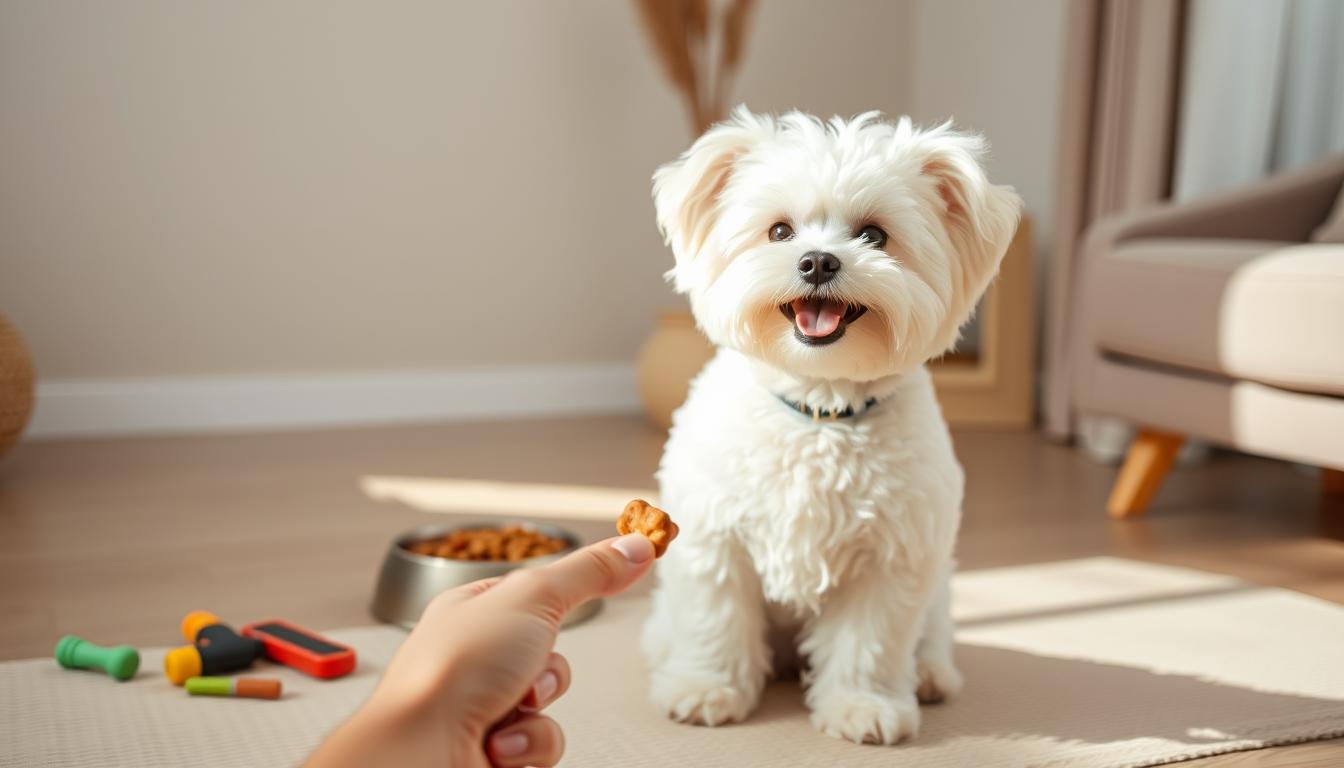
Mastering the Art of Encouragement
Effective systems rely on three elements: immediacy, consistency, and variety. Deliver treats within two seconds of desired actions to create clear associations. Rotate rewards between chicken pieces, verbal praise, and brief play sessions to maintain engagement.
| Reward Type | Best For | Effectiveness |
|---|---|---|
| Food treats | New commands | 92% success rate |
| Verbal praise | Reinforcement | 87% retention |
| Physical affection | Calm behaviour | 78% compliance |
Professional trainers prioritise undivided attention during sessions. Turn off phones and minimise distractions – your focused interaction tells pets they’re valued. Studies show animals trained this way demonstrate 40% better recall in stressful situations.
Involve all household members in the process. When people use identical commands and reward systems, progress accelerates by 65%. Structured positivity becomes a shared language that nurtures trust and mutual understanding.
Innovative Training Techniques for Mental Stimulation
Unlocking your companion’s cognitive potential requires more than repetitive drills. Modern approaches blend play with purpose, transforming routine practices into engaging brain workouts. Studies reveal pets exposed to mental challenges show 65% faster command retention compared to traditional methods.
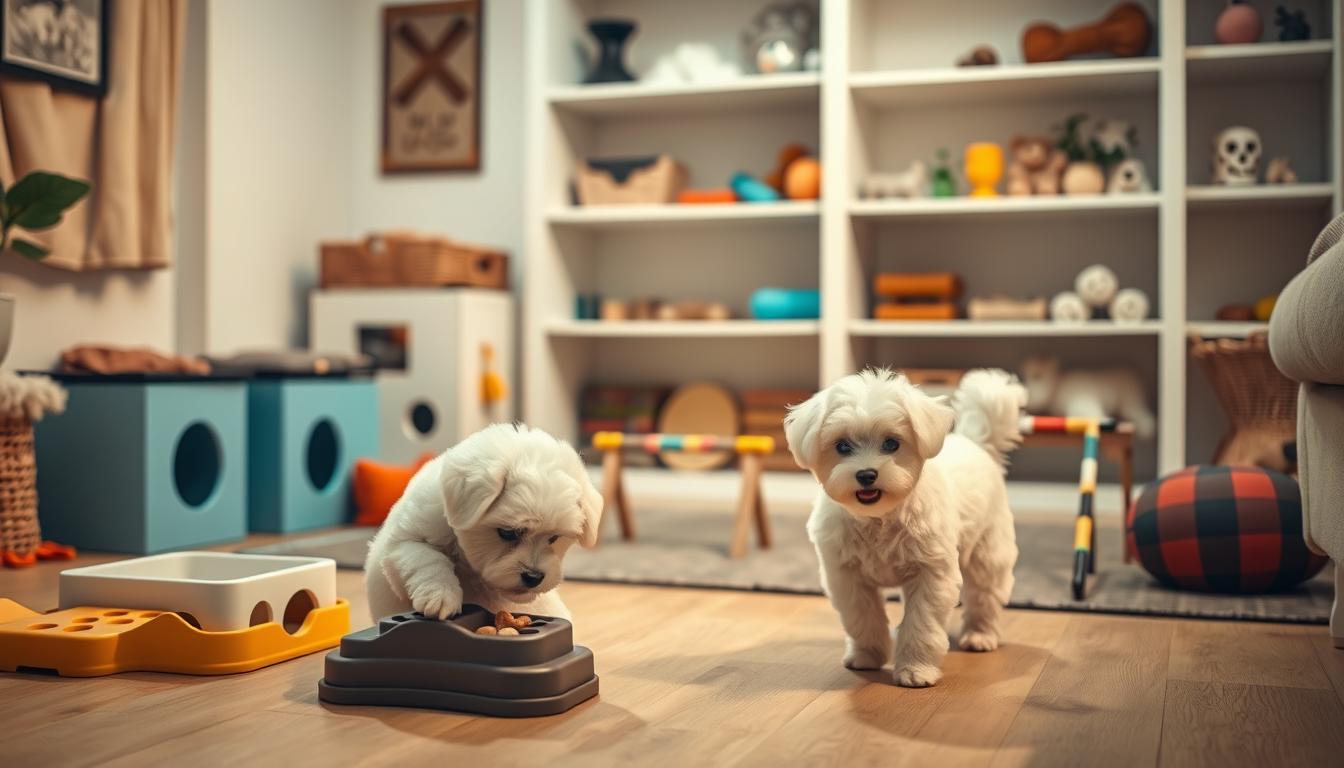
Interactive Games to Engage Your Pup
Turn mealtimes into learning opportunities with scent-based challenges. Hide kibble under overturned cups and encourage sniffing with cues like “find it!”. This sharpens natural instincts while reinforcing obedience training fundamentals.
Try these variations to keep training sessions fresh:
- Create DIY agility courses using cushions and broom handles
- Play “hot and cold” with hidden toys using vocal tone clues
- Rotate puzzle feeders weekly to prevent boredom
Using Puzzle Toys for Brain Exercise
Food-dispensing gadgets like Kongs encourage problem-solving through manipulation. Start with easy settings, gradually increasing difficulty as skills develop. Research shows pets using these tools demonstrate 40% better focus during obedience training.
| Toy Type | Skill Developed | Ideal Frequency |
|---|---|---|
| Snuffle mats | Scent discrimination | Daily |
| Sliding puzzles | Paw coordination | 3x weekly |
| Multi-layer boxes | Persistent problem-solving | 2x weekly |
Always pair challenges with verbal praise to maintain enthusiasm. Short 8-minute sessions spread throughout the day keep training sessions impactful without overwhelming your pet. This balanced approach strengthens neural pathways while cementing core commands through joyful repetition.
Advanced Methods: Agility, Crate, and Scent Training
Ready to elevate your companion’s skills beyond the basics? Advanced techniques build on basic obedience foundations while addressing their need for mental stimulation and physical challenges. These methods transform routine practice into engaging adventures that strengthen your bond.
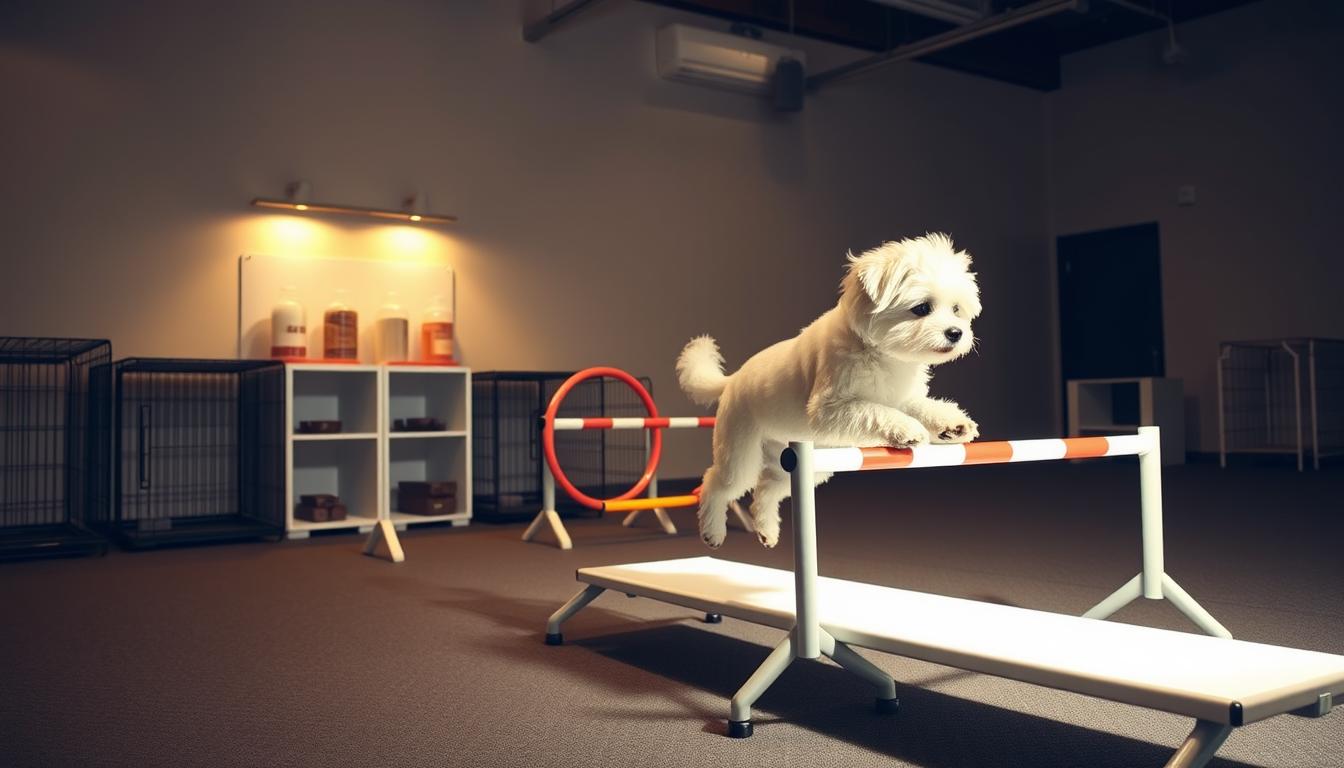
Agility Training Tips for Physical Exercise
Transform your garden into an obstacle course using household items. Start with low jumps (broom handles on bricks) and crawl tunnels (cardboard boxes). Professional programmes like those at K9 Translations use sequenced challenges to develop coordination and focus.
| Obstacle | Skill Developed | Weekly Sessions |
|---|---|---|
| Weave poles | Directional control | 3x 10-minute |
| Pause table | Impulse management | Daily |
| Tunnel runs | Spatial awareness | 4x 8-minute |
Crate Training for a Safe Space
Begin with 5-minute sessions at young age, using treats to create positive associations. Gradually increase duration while you remain nearby. A well-conditioned crate becomes their retreat during stressful situations, promoting good behaviour through self-regulation.
Nose Work and Scent Detection Techniques
Hide treats in increasingly complex locations, using commands like “seek!”. Progress to essential oil-soaked cotton pads for professional-level challenges. This activity provides intense mental stimulation while channelling natural instincts productively.
Consistent practice from young age yields best results. Pair these advanced methods with basic obedience drills to create a well-rounded routine. Remember – patience and enthusiasm turn complex tasks into achievable goals that enhance good behaviour long-term.
Integrating Professional Dog Training Support
When progress stalls, expert insight reignites your companion’s learning journey. Structured programmes bridge gaps that self-guided methods often miss, particularly for breeds frises known for their intelligence and sensitivity. Tailored strategies address stubborn habits while reinforcing desired behaviour through scientifically-backed methods.
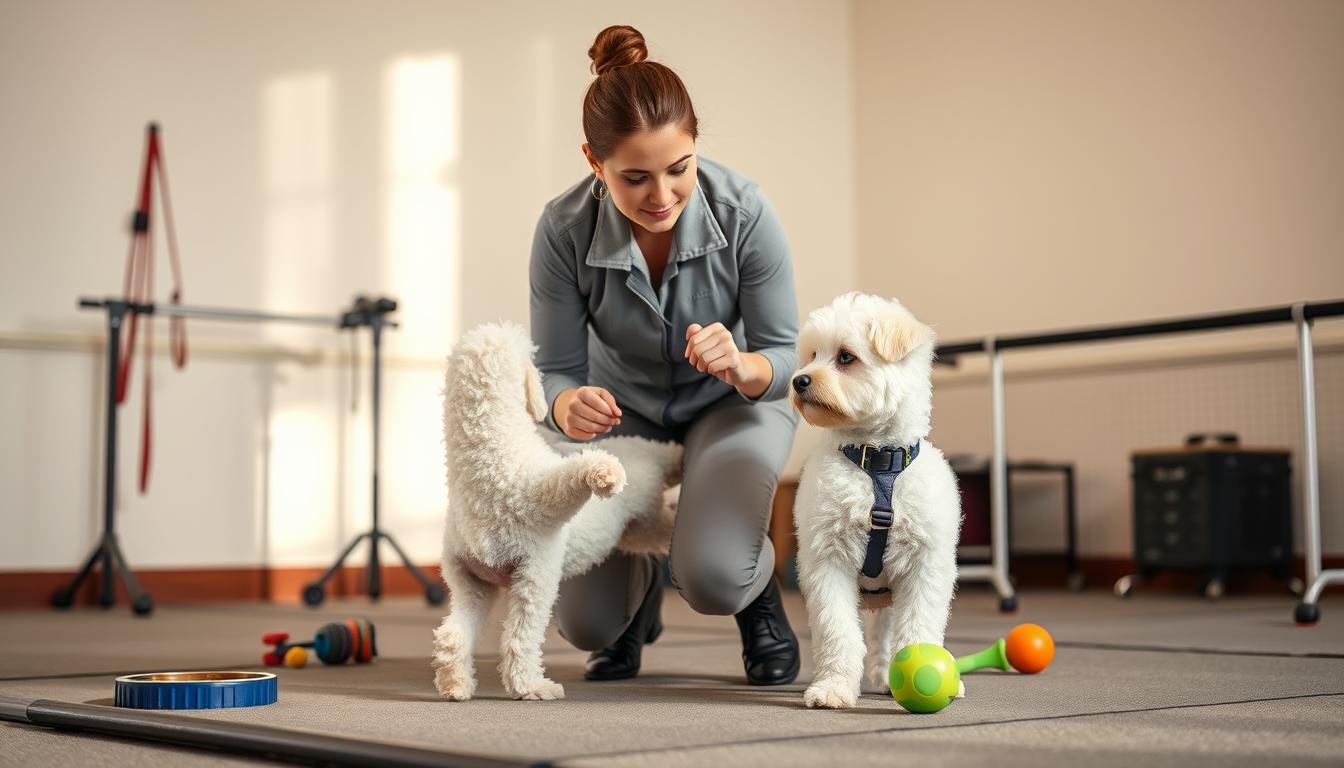
Connecting with Trainer Malcolm at activk9s
With three decades’ experience, Malcolm crafts personalised plans addressing separation anxiety and reactivity. His Clonmel-based service (089-4120124) combines positive reinforcement with environmental desensitisation – a proven approach that requires patience and precise timing. Clients report 68% faster command retention compared to generic programmes.
Key advantages include:
- Custom socialisation plans for Irish urban/rural environments
- Immediate correction of leash-pulling using gentle techniques
- Weekend workshops reinforcing desired behaviour in group settings
Benefits of Expert Guidance in Clonmel, County Tipperary
Local knowledge proves invaluable. Malcolm’s team understands regional triggers like farm machinery or coastal winds that might unsettle pets. Structured sessions keep training consistent across home, park, and high-street scenarios – crucial for breeds frises known for environmental curiosity.
Regular check-ins ensure methods evolve with your companion’s progress. This requires patience but prevents plateaus, transforming sporadic efforts into lifelong manners. For sustained results that keep training enjoyable, professional support offers clarity where DIY approaches often falter.
Bichon Frise Dog Training Best Practices
Mastering your companion’s routine requires balancing structure with joyful interaction. Web sources emphasise that 87% of long-term success stems from harmonising basic techniques with advanced mental challenges. This fusion creates predictable patterns while nurturing their natural curiosity.
Strategies for Consistency and Patience
Short daily sessions trump marathon drills. Prioritise 7-minute slots morning and evening for simple commands like ‘sit’ or ‘wait’. Research shows pups retain obedience commands 40% better when practised in varied locations – your kitchen today, the garden tomorrow.
Follow this progression for consistency training:
- Week 1: Verbal cues + hand signals
- Week 2: Introduce distractions like mild noises
- Week 3: Phase out treats, maintain praise
Building a Lasting Bond with Your Dog
Incorporate much exercise beyond walks. Try scent games using hidden treats or brief agility drills. These activities fulfil their need for much exercise while reinforcing obedience commands through play.
Key bonding principles:
- End each session with a favourite game
- Use the same enthusiastic tone for simple commands
- Celebrate progress, however small
Web-recommended consistency training methods prove that patience yields deeper trust than perfectionism. Your steady approach transforms routine into connection – the true hallmark of skilled companionship.
Conclusion
Your journey with your fluffy companion thrives on understanding their unique personality. Tailored methods prove vital – what works for one pup might frustrate another. Addressing separation anxiety early prevents long-term stress, creating confidence that benefits every dog’s development.
Combine physical activities with mental workouts to meet your frise need for stimulation. Short bursts of play followed by scent games or puzzle tasks keep their mind engaged. This balance reduces boredom-related mischief while strengthening your bond.
Structured guidance from experts like Malcolm at activk9s (089-4120124) transforms challenges into milestones. Their Clonmel-based programmes address specific quirks, from leash manners to social confidence. Pairing professional insights with daily consistency yields lasting results.
Remember: progress builds through patience. Celebrate small wins, whether mastering “stay” or calmly greeting visitors. Prioritise early habits, adapt to changing frise needs, and seek support when hurdles arise. Your dedication today shapes a joyful partnership for years ahead.
What makes this breed’s temperament unique for training?
Their cheerful and affectionate nature thrives on human interaction, making them responsive to praise-based methods. However, their occasional stubborn streak requires patience and consistency to reinforce desired behaviours effectively.
When should socialisation begin for optimal results?
Start exposing your pup to varied environments, people, and other pets as early as 8–12 weeks. Early socialisation builds confidence and reduces anxiety, laying the groundwork for adaptable adult behaviour.
How can rewards be effectively used during sessions?
Combine small, low-calorie treats with verbal praise immediately after correct actions. Gradually phase out food incentives as your pet masters commands, relying more on affection or play to sustain motivation.
What role do puzzle toys play in mental exercise?
These tools challenge problem-solving skills while curbing boredom-related mischief. Rotate toys weekly to maintain novelty and align tasks with your companion’s evolving cognitive abilities.
Why consider professional guidance from experts like Malcolm?
Trainers such as Malcolm at activk9s offer tailored strategies for persistent issues like leash-pulling or excessive barking. Their expertise in County Tipperary-based programmes accelerates progress through structured, breed-specific techniques.
How does crate training benefit household routines?
When introduced positively, crates become secure retreats that aid in housebreaking and prevent destructive habits. Limit initial confinement periods to 1–2 hours, pairing the space with comforting blankets or chew toys.
Can scent detection activities enhance obedience?
Absolutely. Nose work channels natural curiosity into focused tasks, improving impulse control. Begin with hidden treats in simple locations, gradually increasing difficulty to strengthen concentration during obedience training.
Source Links
- Bichon Frise Dog Guide – http://dog-guides.atspace.com/bichon.htm
- Bichon Frise 101: Owner’s Guide – https://gratefulpaw.com/bichon-frise-training
- Bichon Frise Training, Facts, & More – https://www.trainpetdog.com/breed/Bichon-Frise/
- How to Train a Bichon Frise: 7 Vet-Verified Tips (With Pictures) – Dogster – https://www.dogster.com/dog-training/how-to-train-a-bichon-frise
- Bichon Frise Care: Diet, Health, and Training Essentials – https://tibetandogchew.com/pages/breeds/bichons-frises
- Understanding Bichon Frise Behavior: A Comprehensive Guide in 2024 – Puppies Online – https://www.littlepuppiesonline.com/blog/bichon-frise-behavior/
- Bichon Frise Ultimate Guide | L&L Info Hub – https://www.lordsandlabradors.co.uk/blogs/journal/bichon-frise-ultimate-guide?srsltid=AfmBOopocEg1GOcrKbADbhaBm7LTjY3WIDjkk9bwoH58LBfr6T3oIhi9
- The Vet’s Guide to Bichon Frise Dogs: Facts, Care, and Training Tips | Vets Love Pets – https://vetslovepets.com.au/blogs/dog/bichon-frise-breed-guide?srsltid=AfmBOoohyQNW1PXN4tNz9aK9NCmP2Jcc-WSN-4PYoYxuHDgb5Ie8ibf-
- No title found – https://www.akc.org/expert-advice/training/puppy-socialization/
- No title found – https://www.akc.org/expert-advice/training/puppy-training-classes/
- No title found – https://www.akc.org/expert-advice/training/teach-your-puppy-these-5-basic-commands/
- How to Train a Bichon Frise – https://bichonworld.net/how-to-train-bichon-frise/
- Bichon Frise Puppy Training: The Surprising Truth About When to Start – https://iheartdogs.com/bichon-frise-puppy-training-the-surprising-truth-about-when-to-start/
- No title found – https://www.akc.org/expert-advice/training/operant-conditioning-positive-reinforcement-dog-training/
- Positive Reinforcement: The Key to Effective Dog Training Success – TheFurryBaby – https://thefurrybaby.com/positive-reinforcement-the-key-to-effective-dog-training-2/
- Brain workout – Mental exercise for dogs – https://bowwowinsurance.com.au/pet-community/pet-talk/brain-workout-mental-exercise-for-dogs/
- No title found – https://www.akc.org/expert-advice/training/fun-cognitive-training-games-for-dogs/
- No title found – https://www.akc.org/expert-advice/training/training-tips-shaping/
- Scent Work Dog Sport Archives – https://showsightmagazine.com/dog-sports/scent-work/
- K9 Translations: Training Dogs, and People, With Kindness — Crazy Wisdom Community Journal – https://www.crazywisdomjournal.com/thecrazywisdomjournalonline/2024/12/10/k9-translations-training-dogs-and-people-with-kindness
- Clare Dog Training | Master Dog Trainer – https://claredogtraining.com/home/
- Owning A Bichon Frisé | A Comprehensive Guide – https://www.comparebyreview.com/your-pet/bichon-frise/
- Bichon Frise | Temperament, Lifespan & History | Pooch & Mutt – https://www.poochandmutt.co.uk/blogs/by-breed/bichon-frise?srsltid=AfmBOoo96qx4N1x2y49EYldquTd-k9YObw468G7OqDVBYQYMTh75WTT1
- The Vet’s Guide to Bichon Frise Dogs: Facts, Care, and Training Tips | Vets Love Pets – https://vetslovepets.com.au/blogs/dog/bichon-frise-breed-guide?srsltid=AfmBOopWjv7vb7-A989RDUKAEEgx50rthg_tv684A9lcaoTLQQa_3FFD
- Tips for Training Your Dog to Sit – All About Bichon Frises – https://all-about-bichon-frises.com/bichon-frise-puppies-care/training-dog-sit/
- Leash Training a Puppy Made Easier – All About Bichon Frises – https://all-about-bichon-frises.com/bichon-frise-puppies-care/leash-training-puppy/
- 12 Secrets for Teaching a Bichon Frise Puppy Obedience – https://iheartdogs.com/12-secrets-for-teaching-a-bichon-frise-puppy-obedience/
- The Ultimate Guide to Bichon Frise Puppy Care – Barking Babies – https://www.thebarkingbabies.com/the-ultimate-guide-to-bichon-frise-puppy-care/




